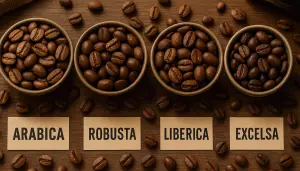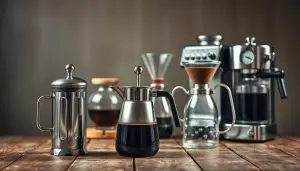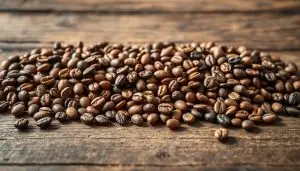The Ultimate Guide to Coffee Beans
Discover the unique flavors and origins of different coffee bean types. Learn how to choose the best beans for your perfect cup.
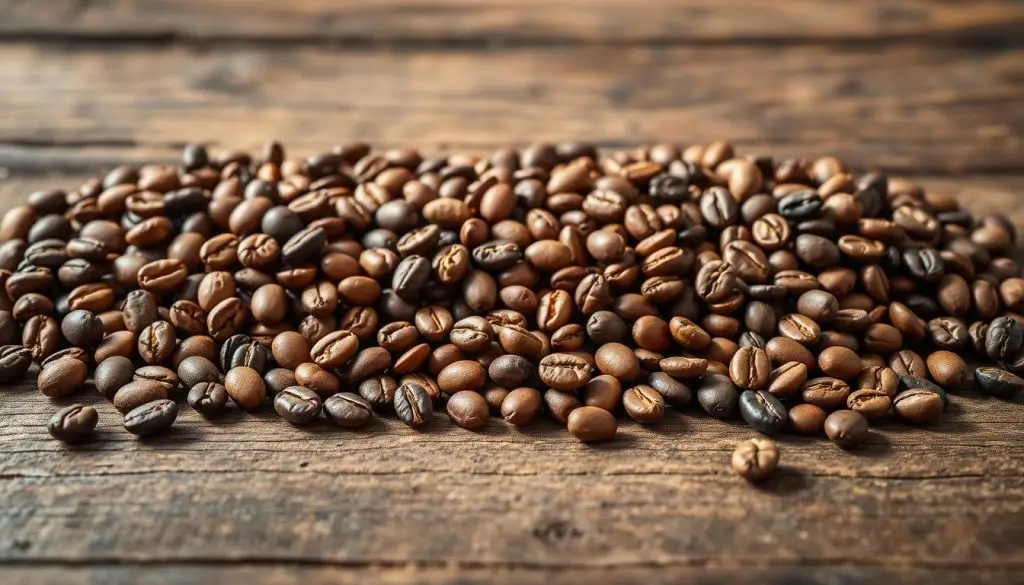
Explore the wide world of coffee bean varieties and take your coffee to the next level. With over 100 species, coffee’s world is both vast and complex.
The two main coffee bean types are Arabica and Robusta. They are known for their unique flavors and textures. Other varieties like Liberica and Excelsa also have their own special traits.
Knowing about the different coffee beans is key. It helps you pick the perfect one that matches your taste.
Key Takeaways
- Arabica and Robusta are the two main coffee bean types.
- Liberica and Excelsa are other notable varieties with unique characteristics.
- Understanding coffee bean types is key to finding the perfect brew.
- Different coffee bean types offer distinct flavors and textures.
- Exploring various coffee bean types can elevate your brewing experience.
Understanding Coffee Bean Basics
To truly appreciate coffee, one must first understand the basics of coffee beans. This includes their origin, processing, and flavor profile. Coffee beans are grown in various regions around the world. They are mainly found in the “coffee belt,” which spans across Central and South America, Africa, and Asia.
Several factors influence the flavor profile of coffee beans. Soil, climate, and altitude all play significant roles. For example, coffee beans grown at high altitudes tend to have a more complex flavor. The type of soil, whether it’s rich volcanic soil or sandy loam, also affects the flavor.
What Makes Coffee Beans Special
Coffee beans are not just any ordinary commodity. They are products of nature, heavily influenced by their environment. The unique combination of climate, soil, and processing methods gives each coffee bean its distinct flavor and aroma. Several key factors make coffee beans special:
- The region in which they are grown
- The altitude at which they are cultivated
- The method used for processing the beans
- The level of roast
For more information on coffee varieties, you can visit Counter Culture Coffee. They provide a detailed guide to understanding different coffee bean types.
The Journey from Plant to Cup
The journey of coffee beans from the plant to the cup involves several critical steps. These steps include harvesting, processing, roasting, and brewing. Each step is vital in determining the final flavor and quality of the coffee.
- Harvesting: Coffee beans are harvested from the coffee plant, typically when ripe.
- Processing: The beans are processed to remove the outer skin and pulp, either through a washed, natural, or honey process.
- Roasting: The processed beans are then roasted to bring out the desired flavor and aroma.
- Brewing: Lastly, the roasted beans are brewed to make coffee.
Understanding these steps and how they affect the coffee’s flavor can help coffee enthusiasts appreciate the complexity and richness of their favorite beverage.
Exploring the Four Main Coffee Bean Types
There are many coffee bean types, but Arabica, Robusta, Liberica, and Excelsa stand out. They differ in taste, quality, and how they’re made.
Arabica: The Premium Choice
Arabica is loved for its smooth, complex flavors. It’s grown at high altitudes, which adds to its rich taste. Coffee experts say Arabica tastes more refined, with hints of fruit and flowers.
“Arabica is the connoisseur’s choice, with a richer and more complex taste.”
Arabica beans cost more because they’re hard to grow and harvest. But they offer a coffee that’s both aromatic and flavorful.
Robusta: The Bold Alternative
Robusta is known for its bold taste and high caffeine. It’s easier to grow and more disease-resistant, making it cheaper. Robusta is often used in instant coffee and espresso for its rich crema.

Some say Robusta lacks the finesse of Arabica. Yet, it has fans who love its strong taste.
Liberica: The Rare Find
Liberica is rare, accounting for only a small share of global coffee. It has a unique flavor with fruit and spice notes. It’s mainly grown in West Africa, like Liberia.
Liberica’s taste is floral and fruity, with a spicy hint. Its unique flavor makes it a favorite among coffee lovers who dare to try new things.
Excelsa: The Distinctive Variety
Excelsa is a mix of Liberica and Arabica. It has a distinctive flavor that combines the best of both. Excelsa is known for its complexity and depth.
- Offers a balanced flavor profile
- Combines the best of Liberica and Arabica
- Gaining popularity among specialty coffee roasters
Arabica vs. Robusta: A Detailed Comparison
Arabica and Robusta are the top two coffee types. They differ in taste, how they’re grown, and caffeine levels. Knowing these differences helps us enjoy coffee more.
Flavor Profiles and Characteristics
Arabica coffee is known for its rich flavors. It tastes fruity, floral, and sweet. Robusta, on the other hand, is bolder and harsher. It has a burnt taste and is more bitter.
- Arabica: Complex flavors, fruity, floral, sweeter
- Robusta: Bold, harsh, burnt, or rubbery taste, bitter
To learn more about their flavors, check out this article. It lists 10 key differences between Arabica and Robusta.
Growing Conditions and Requirements
Arabica coffee needs cooler, high places with lots of rain. This makes it harder to grow. Robusta, by contrast, grows well in warmer, lower-lying areas with less rainfall.
- Arabica: High altitude, cooler temperatures, ample rainfall
- Robusta: Lower altitude, warmer temperatures, less rainfall required
Caffeine Content and Health Aspects
Robusta has more caffeine than Arabica. This makes it great for those who want a stronger coffee. But, Arabica’s lower caffeine and richer taste make it a hit with coffee lovers.
- Caffeine Content: Robusta has higher caffeine, Arabica has lower caffeine
- Health Aspects: Arabica is seen as healthier because of its lower caffeine and more antioxidants
In summary, picking between Arabica and Robusta depends on what you like, how you brew it, and how much caffeine you want. Both offer unique qualities for different tastes and needs.
Popular Coffee Bean Varietals Around the World
Coffee from around the globe offers a wide range of flavors. From Ethiopian coffee’s bright, fruity notes to Asian beans’ earthy profiles, each region has its own unique taste. Coffee lovers often seek out specialty coffee beans from famous areas. The local climate, soil, and how they’re processed shape these beans.
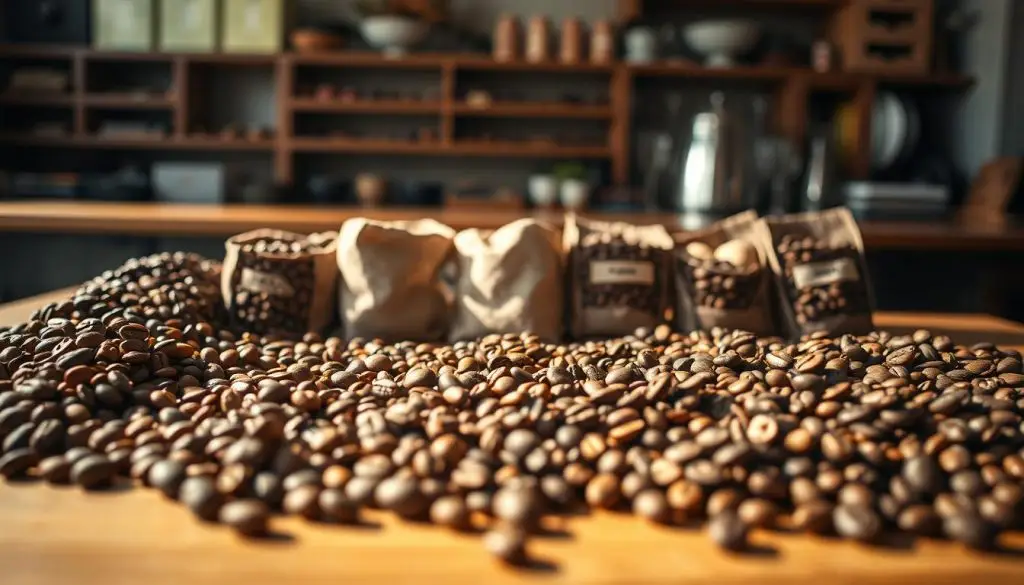
Ethiopian Varieties
Ethiopian coffee is known for its floral and fruity flavors. Varieties like Geisha and Heirloom are favorites. Geisha is prized for its complex taste and high quality. Heirloom beans, on the other hand, offer a wide range of flavors due to their genetic diversity and traditional farming practices.
To learn more about coffee beans, including Ethiopian ones, check out CoffeeHit’s guide on the 4 most popular coffee beans.
Central American Varieties
Central American coffee is known for its balanced taste and smooth finish. Varieties like Bourbon and Typica are highly regarded. Bourbon is a sweet, balanced spirit, produced in several Central American countries. Typica, one of the oldest varieties, has a classic taste with chocolate and fruit notes.
Pacamara, from Central America, is famous for its large beans and complex flavor. It often has fruit and wine notes.
Asian Varieties
Asian coffee, including Java and Sumatra beans, has earthy and herbal flavors. Sumatra Mandheling is known for its rich, full-bodied taste with low acidity. Java coffee has a balanced flavor with a hint of sweetness.
The variety of flavors in these popular coffee bean varietals shows the impact of region, climate, and processing. Whether you’re a coffee expert or new to it, knowing about these varietals can deepen your appreciation for coffee.
Understanding Single-Origin Coffee Beans
Single-origin coffee beans are loved for their unique taste. They come from one place, unlike blended coffees. This makes them special because they have a flavor that’s all their own.
What Makes Single-Origin Special
These beans come from a specific place, like a farm. This means they keep the area’s taste. For example, Kenyan coffee is bright and complex, while Brazilian coffee is smooth and chocolatey.
Key characteristics of single-origin coffee beans include:
- Distinct flavor profiles: They show the soil, climate, and how they were made.
- Traceability: You can find out where the coffee came from, which is cool.
- Quality: They’re often seen as better quality because of how they’re chosen and made.

Popular Single-Origin Regions
Many places are famous for their single-origin coffee beans. Some top ones are:
- Ethiopia: Known for its unique flavors and heirloom varieties.
- Colombia: Famous for its balanced taste and rich flavors.
- Kenya: Loved for its bright taste and complex flavors.
- Sumatra: Known for its earthy and herbal notes.
These places offer a wide range of tastes. This makes single-origin coffee beans exciting for coffee lovers to explore.
Specialty Coffee Bean Types and Classifications
For coffee lovers, specialty coffee is the top choice. It’s all about quality and uniqueness. Specialty coffee beans are ranked based on their quality, flavor, and processing methods.
Grading and Classification Systems
The grading of specialty coffee looks at flavor, aroma, and acidity. The Specialty Coffee Association (SCA) has a well-known system. Coffees scoring 80 points or higher are considered top-notch.
- Flavor profile: The unique taste of the coffee.
- Aroma: The scent, which can be floral or fruity.
- Acidity: The sharp, lively feel of the coffee.
To explore coffee bean varieties, check out Counter Culture Coffee’s guide on coffee basics.
Ethical and Sustainable Practices
Ethical and sustainable practices are key in specialty coffee. This includes fair trade, organic farming, and eco-friendly processing. People are willing to pay more for coffee that tastes great and supports farmers and the planet.
“Sustainability is not just a buzzword; it’s a necessity for the long-term viability of our industry.”
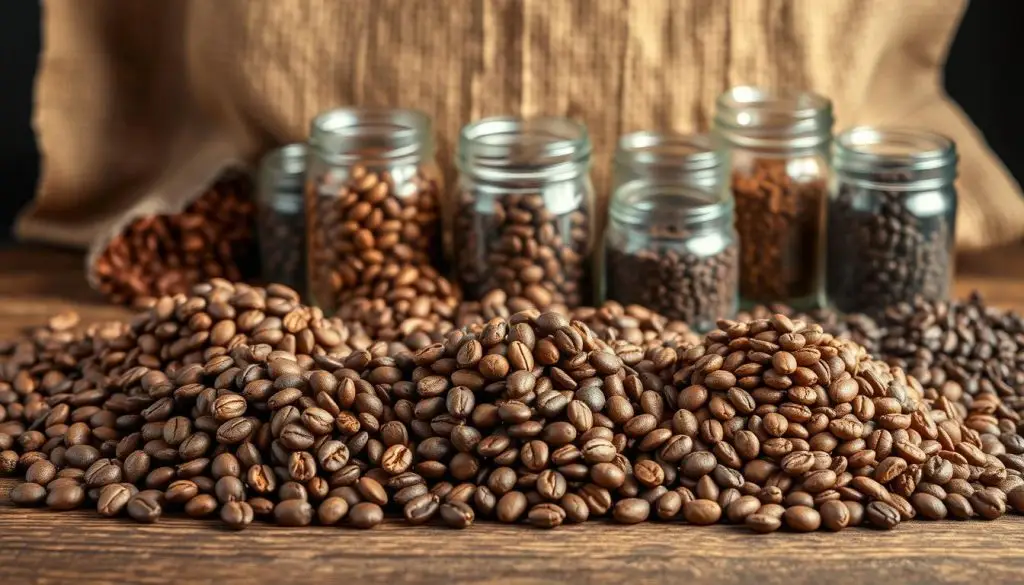
Third Wave Coffee Movement
The Third Wave Coffee movement sees coffee as an artisanal product. It focuses on the skill of coffee making and the special qualities of each bean. This movement has made people appreciate single-origin coffees and new processing methods.
- High-quality, unique coffee beans are emphasized.
- New brewing methods and techniques are explored.
- The art and craft of coffee-making are highlighted.
The Third Wave Coffee movement has changed how we see and enjoy coffee. It’s driven the demand for the best coffee bean varieties and unique coffee experiences.
Coffee Bean Processing Methods
The way coffee beans are processed significantly affects their taste, smell, and quality. Coffee processing methods are key in shaping the beans’ final flavor. This makes it a critical step in coffee making.
Washed Process
The washed process removes the skin and pulp of the coffee cherry before drying. This method gives a cleaner, brighter taste. Washed processing brings out the coffee’s acidity and flavor nuances.
Natural/Dry Process
The natural or dry process dries the coffee cherries whole, with the fruit on the bean. This method creates fruitier, sweeter tastes. Natural processing makes the coffee’s body heavier and its flavor more complex.
Honey/Pulped Natural Process
The honey or pulped natural process removes the coffee cherry’s skin but keeps some pulp during drying. It offers a sweet and fruity taste. This method makes the coffee’s body heavier than washed coffees but cleaner than natural coffees.
Experimental Processing Techniques
Coffee makers are always experimenting with new processing methods to create unique flavors. These experimental methods include varying drying times and fermentation conditions. Innovative processing techniques are expanding what’s possible in coffee flavors.
In summary, the coffee bean processing method is vital in shaping its taste. Knowing these methods helps coffee lovers appreciate the skill that goes into making their favorite coffee.
How to Choose the Right Coffee Bean Types for Your Taste
The world of coffee is vast, and finding the ideal coffee bean type requires some exploration. With so many options available, understanding your preferences is key to making an informed decision.
Understanding Roast Levels
Coffee roast levels range from Light to Dark, each with a unique flavor profile. Light roasts are known for their bright acidity and fruity notes. On the other hand, Dark roasts offer a richer, bolder taste with deeper caramelized flavors.
When choosing a roast level, consider your taste preferences. If you enjoy a brighter cup, Light to Medium roasts might be your choice. For a bolder taste, Dark roasts are the way to go.
Matching Beans to Brewing Methods
The brewing method significantly impacts the flavor of your coffee. For instance, French Press requires a coarser grind and a bolder bean, like a Dark Roast, to bring out the full flavor.
- For Pour-over and Chemex, a medium grind and a balanced roast work well.
- Espresso requires a fine grind and a robust bean, often a Dark Roast, to achieve the perfect crema.
Experimenting with different brewing methods can help you find the perfect match for your favorite coffee bean type. For more detailed guidance on brewing methods, you can visit Instructables for additional tips.
Experimenting with Blends vs. Single Origins
Coffee blends offer a balanced flavor by combining beans from different regions. On the other hand, Single-Origin coffees provide a distinct taste characteristic of their area.
Blends are great for those who enjoy a consistent flavor. Single-origin coffees are ideal for adventurers looking to explore different flavor profiles.
Storing and Preserving Your Coffee Beans
Proper storage is key to maintaining the freshness of your coffee beans. Store them in an airtight container in a cool, dark place to preserve their flavor.
- Avoid storing coffee beans in the refrigerator or freezer, as moisture can affect their taste.
- Keep the container away from direct sunlight and heat sources.
By understanding roast levels, matching beans to brewing methods, experimenting with blends and single origins, and storing your coffee beans properly, you can elevate your coffee experience. Find the perfect cup that suits your taste.
Conclusion
The world of coffee is incredibly diverse. It offers many coffee bean types and roast levels to explore. Knowing these differences can enhance your coffee experience, whether you drink it casually or are a coffee expert.
There’s a wide range of flavors to try. Ethiopian coffee has bright, fruity tastes, while Brazilian coffee has smooth, chocolatey notes. By trying different coffee beans, roast levels, and brewing methods, you can find the perfect cup for you.
This guide has shown you the main coffee bean types: Arabica, Robusta, Liberica, and Excelsa. Each has its own unique taste. Trying different beans and roast levels can help you find your favorite flavor, whether it’s bold and rich or light and nuanced.
Now, you can confidently explore the world of coffee. You know about the many types of coffee beans and flavors out there. Start your coffee journey and find the perfect cup that suits your taste.
FAQ
What are the four main types of coffee beans?
The main types are Arabica, Robusta, Liberica, and Excelsa. Each has its own taste and characteristics.
What is the difference between Arabica and Robusta coffee beans?
Arabica has a more complex taste and grows in cooler places. Robusta is stronger and has more caffeine, great for espresso.
What are single-origin coffee beans?
Single-origin beans come from one place or farm. They have a unique taste that shows where they’re from.
How does the processing method affect the flavor of coffee beans?
Processing methods change the taste of coffee beans. Washed beans taste cleaner, while natural beans are fruitier.
What is specialty coffee, and how is it classified?
Specialty coffee is top-notch, with unique flavors. It’s graded based on taste, smell, and acidity.
How do I choose the right coffee bean type for my taste?
Know how roast and brewing methods change flavor. Try different blends and single-origin beans to find your favorite.
What are some popular coffee bean varietals, and what are their characteristics?
Ethiopian beans like Geisha and Heirloom have floral and fruity tastes. Central American beans like Bourbon are balanced. Asian beans like Java are earthy.
How do roast levels impact the flavor of coffee?
Roast levels change coffee’s taste. Lighter roasts are bright and fruity. Darker roasts are richer and more profound.
